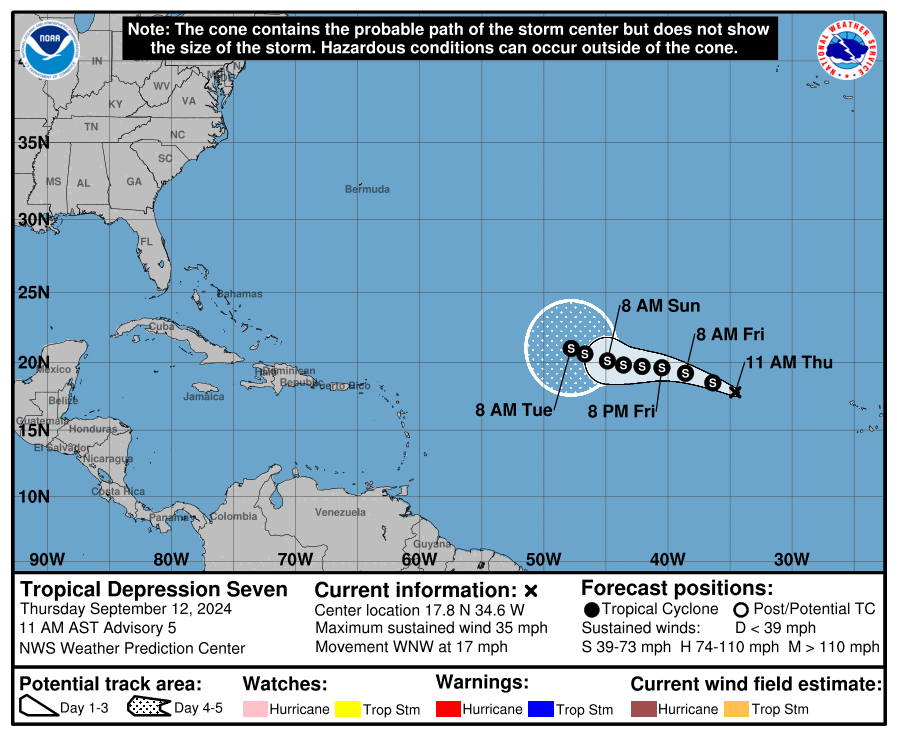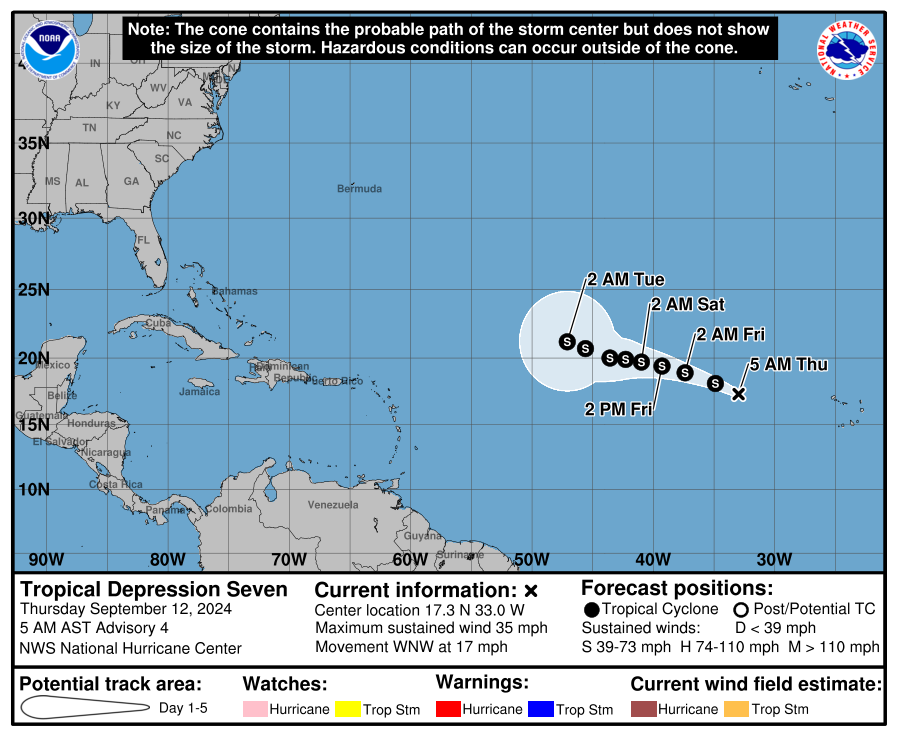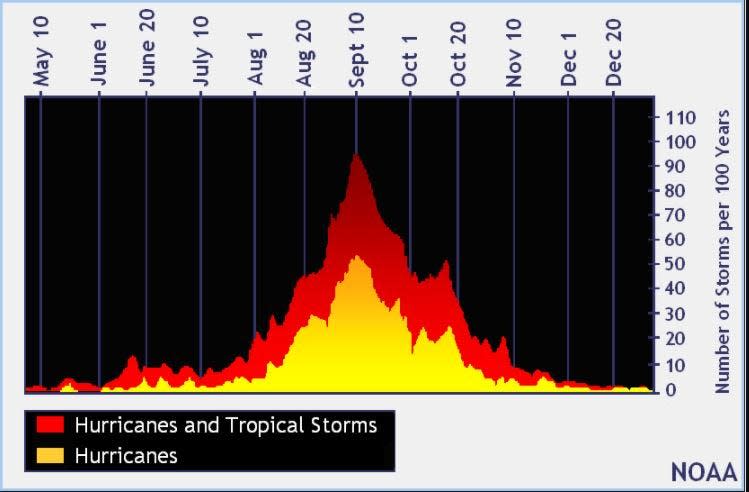In a hurry? Here’s what’s happening with Francine – in less than a minute.
The National Hurricane Center is tracking a tropical depression, one invest and a system of low pressure off the coast of Florida.
Francine made landfall Wednesday night as a Category 2 hurricane in Terrebonne Parish in Louisiana with maximum sustained winds near 100 mph. On Thursday afternoon, the NHC stopped advisories on Francine, now weakened to a post-tropical cyclone. Any additional updates will come from the Weather Prediction Center.
➤ Weather alerts via text: Sign up to get updates about current storms and weather events by location
Elsewhere in the Atlantic basin, forecasters are tracking:
-
A system of low pressure off the coast of Florida that currently has a low chance for development. Chances for some subtropical or tropical development are possible next week.
-
One invest, several hundred miles east of the Leeward Islands, currently has a 30% chance for development.
-
And, in the far central Atlantic, Tropical Depression 7 formed Wednesday and could become Tropical Storm Gordon tonight or Friday.
➤ Spaghetti models for Tropical Depression 7
Here’s the latest update from the NHC as of 5 p.m. EDT Sept. 12:
Where is Post-Tropical cyclone Francine?

The National Hurricane Center issued its final advisory on Francine at 11 a.m. EDT.
On the forecast track, the center of Francine will move over central and northern portions of Mississippi this afternoon and tonight and move into northeastern Arkansas by Friday.
Francine is expected to be dissipated in 36 hours.
Francine will continue to bring heavy rainfall and the risk of flash and urban flooding, along with river flooding, across portions of the Lower Mississippi Valley, Tennessee Valley and the Southeast. Considerable flash and urban flooding is possible through tonight over portions of Alabama and the Florida Panhandle, expanding into Georgia and middle Tennessee Friday.
➤Spaghetti models for Francine
A few tornadoes are possible through this evening across the Florida Panhandle, southern and central Alabama, and southwest Georgia.
Tropical Depression 7 could become Tropical Storm Gordon today


-
Location: 800 miles west-northwest of Cabo Verde Islands
-
Maximum sustained winds: 35 mph
-
Movement: west-northwest at 16 mph
-
Pressure: 1007 mb
What you should know about Tropical Depression 7


At 5 p.m., the center of Tropical Depression Seven was located near latitude 18.3 North, longitude 35.9 West.
The depression is moving toward the west-northwest near 16 mph, and a west-northwest to west motion at a slower forward speed is anticipated over the next few days.
Tropical Depression 7 impacts: Will Florida feel impacts from Tropical Depression 7, ‘tropical rainstorm’ soon? What to know
Maximum sustained winds are near 35 mph with higher gusts.
Some strengthening is forecast during the next 48 hours, and the depression could become a tropical storm tonight or on Friday.
The estimated minimum central pressure is 1007 mb.
Spaghetti models for Tropical Depression 7
Special note about spaghetti models: Spaghetti model illustrations include an array of forecast tools and models, and not all are created equal. The Hurricane Center uses only the top four or five highest performing models to help make its forecasts.
What else is out there and how likely are they to strengthen?


Offshore the Southeastern U.S. over the western Atlantic: A non-tropical area of low pressure could form along a residual frontal boundary a few hundred miles off the southeastern U.S. coastline this weekend.
Thereafter, some subtropical or tropical development is possible during the early part of next week while the system drifts to the north or northwest.
-
Formation chance through 48 hours: low, near 0 percent.
-
Formation chance through 7 days: low, 30 percent.
Invest 94L, east of the Leeward Islands: Showers and thunderstorms continue to show signs of organization in association with a small area of low pressure located a few hundred miles east of the Leeward Islands.
However, the proximity of dry air near the system could limit additional development over the next couple of days. Environmental conditions are expected to become even less conducive over the weekend while the system moves slowly west-northwestward.
Regardless of development, this system could produce locally heavy rainfall and gusty winds across the northern Leeward Islands on Friday.
-
Formation chance through 48 hours: low, 30 percent.
-
Formation chance through 7 days: low, 30 percent.
What do the colored areas on the NOAA map mean?
The hatched areas on a tropical outlook map indicate “areas where a tropical cyclone — which could be a tropical depression, tropical storm or hurricane — could develop,” said National Hurricane Center Deputy Director Jamie Rhome.
The colors make it visibly clear how likely a system could develop with yellow being low, orange medium and red high.
The National Hurricane Center generally doesn’t issue tropical advisories until there is a named storm, but there is an exception.
“If a system is near land and there is potential for development, the National Hurricane Center won’t wait before it issues advisories, even if the system hasn’t become an actual storm. This gives residents time to prepare,” Rhome said.
What is an invest?
Short for investigation, the National Hurricane Center uses the term invest for areas of low pressure it is monitoring for potential development into a tropical depression or storm.
Invests are not tropical depressions or tropical storms. They’re usually clusters of showers and thunderstorms, and just because they’ve been designated as an invest does not guarantee they’ll develop into a tropical cyclone.
Invests run from 90 to 99, followed by a letter: L for the Atlantic basin and E for those in the eastern Pacific. After 99, it starts over again and the next invest would be 90.
Once something has been designated as an invest, specialized data sets and computer models can begin, including scheduling Hurricane Hunter aircraft missions and the running spaghetti models.
Who is likely to be impacted?
Impacts from Tropical Depression Francine include a threat for tornadoes, heavy rain and gusty winds across portions of the Panhandle today.
The system of low pressure off the southeastern coast is not expected to directly impact Florida, but some increased wave action and rough surf and rip currents are possible, especially in North Florida early next week. Regardless of development, the Carolinas could see coastal erosion and flooding, significant rainfall and gusty winds.
Tropical Depression Seven is expected to remain in the Atlantic and pose no threat to land.
It’s too early at this time to determine if there will be any impact to Florida or the U.S. from the tropical disturbance east of the Leeward Islands.
Forecasters urge all residents to continue monitoring the tropics and to always be prepared. That advice is particularly important for what is expected to be a very active hurricane season.
Weather watches and warnings issued in Florida
When is the Atlantic hurricane season?
The Atlantic hurricane season runs from June 1 through Nov. 30.
The Atlantic basin includes the northern Atlantic Ocean, Caribbean Sea and Gulf of Mexico.
Stay informed. Get weather alerts via text
When is the peak of hurricane season?


The peak of the season is Sept. 10, with the most activity happening between mid-August and mid-October, according to the Hurricane Center.
National Hurricane Center map: What are forecasters watching now?
Systems currently being monitored by the National Hurricane Center include:


Interactive map: Hurricanes, tropical storms that have passed near your city
Excessive rainfall forecast
What’s next?
We will continue to update our tropical weather coverage daily. Download your local site’s app to ensure you’re always connected to the news. And look for our special subscription offers here.
This article originally appeared on Treasure Coast Newspapers: Tropical update: Francine, storm Gordon ahead and Invest 94L
Source Agencies


